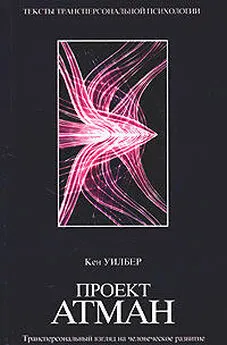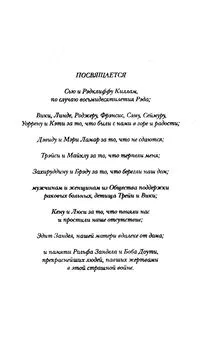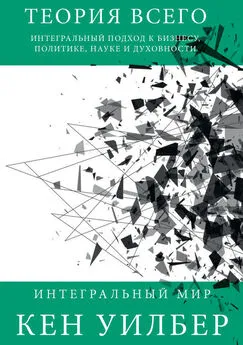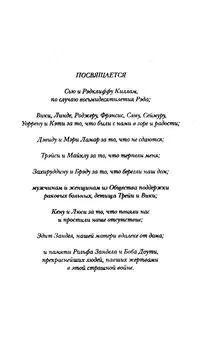Кен Уилбер - Проект Атман
- Название:Проект Атман
- Автор:
- Жанр:
- Издательство:Издательство АСТ
- Год:2004
- Город:Москва
- ISBN:5–17–021069–8
- Рейтинг:
- Избранное:Добавить в избранное
-
Отзывы:
-
Ваша оценка:
Кен Уилбер - Проект Атман краткое содержание
В книге одного из ведущих теоретиков трансперсональной психологии сопоставляются взгляды наиболее известных психологических школ и духовных традиций на эволюцию человека. Делается попытка аналитически разрешить проблему достижения всеединства — или проекта Атмана — как называет ее автор.
Издатели благодарят Алексея Купцова, чья финансовая помощь и дружеская поддержка сделали возможной публикацию этой книги. Перевод с английского под редакцией Александра Киселева Научный редактор кандидат философских наук Владимир Майков Серийное оформление Павла Иващука
© Ken Wilber, 1980
© Институт трансперсональной психологии, 2004
© Издательство К. Кравчука, 2004
© Оформление ООО «Издательство ACT», 2004
Тираж 3000 экз.
Проект Атман - читать онлайн бесплатно полную версию (весь текст целиком)
Интервал:
Закладка:
[233]. Krishnamurti, J. Commentaries on living. Series 1–3. Wheaton, Quest, 1968.
[234]. Kuhn, T. The structure of scientific revolutions. Chicago: Univ. of Chicago Press, 1962.
[235]. LaBarre, W. The human animal. Chicago: Univ of Chicago Press, 1954.
[236]. Lacan, J. Language of the self. Baltimore: John Hopkins, 1968.
[237]. Lacan, J. «The insistence of the letter in the unconscious». In Ehrmann, J., reference note #101.
[238]. Laing, R. D. The divided self. Baltimore: Penguin, 1965.
[239]. Laing, R. D. The politics of experience. New York» Ballantime, 1967.
[240]. Levi‑Strauss, С Structural anthropology. New York: BasicBooks, 1963.
[241]. Lifton, R. Revolutionary immortality. New York: Vintage, 1968.
[242]. Lilly, J. The center of the cyclone. New York: Julian, 1972.
[243]. Loevinger, J. Ego development. San Francisco: Jossey‑Bass, 1976.
[244]. Loewald, H. «The superego and the ego‑ideal. II: Superego and time». International Journal of Psychoanalysis, vol. 43, 1962.
[245]. Loewald, H. «On motivation and instinct theory» Psychoanalytic Study of the Child, vol.26, 1971.
[246]. Loewald, H. Psychoanalysis and the history of the individual. New Haven: Yale, 1978.
[247]. Lonergan, B. Insight, a study of human understanding. New York: Philosophical Library, 1970.
[248]. Longchenpa, Kindlybent to ease us. cols. 1–2. Guenther, H., trans. Emeryville: Dharma press, 1975.
[249]. Loween, A. Thebetrayal of thebody. New York: Macmillan, 1967.
[250]. Loween, A. The language of thebody. New York: Macmillan, 1967.
[251]. Loween, A. Depression and thebody. Baltimore: Penguin, 1973.
[252]. Luk, C. Ch’’an and Zen teaching, Series 1–3. London: Rider, 1960,1961, 1962.
[253]. Luk, C. The secrets of Chinese meditation. New York: Weiser, 1971.
[254]. Luk, C. PracticalBuddhism. London: Rider, 1972.
[255]. Luk, C. trans. The Surangama Sutra. London: Rider, 1969.
[256]. Luk, C. trans. The Vimalakirti Nirdessa Sutra. Berkeley: Shambhala, 1972.
[257]. Maddi, S. Personality theories. Homerwood: Dorsev Press. 1968.
[258]. Maezumi, H. T., and Glassman, B. T. (ed). Zen writings series. vols.1–5, 1976–1978. Los Angeles: Center Publications.
[259]. Mahrer, A. Experiencing. New York» Brunner/Mazel, 1978.
[260]. Marcel, G. Philosophy of existence. New York» Philosophical Library, 1949.
[261]. Marcuse, H. Eros and civilization. Boston: Beacon, 1955.
[262]. Maslow, A. Toward a psychology ofbeing. New York: Van Nostrand Reinhold, 1968.
[263]. Maslow, A. The farther reaches of human nature. New York: Viking, 1971.
[264]. Masters, R., and Houston, J. The varieties of psychedelic experience. New York: Delta, 1967.
[265]. May, R. Love and will. New York: Norton, 1969.
[266]. May, R., ed. Existential psychology. New York: Random House, 1969.
[267]. Mead, G. H. Mind, self, and society. Chicago: Univ. of Chicago Press, 1934.
[268]. Mead, G. R. S. Apollonius of Tyana. New Hyde Park. N. Y.: UniversityBooks, 1966.
[269]. Meil, J. «Jacques Lacan and the structure of the unconscious» In Ehrmann, J., reference note #101.
[270]. Mishra, R. S. Yoga sutras. Garden City: Anchor, 1973.
[271]. Mitchell, E. Psychic exploration. White, J., ed. New York: Capricorn, 1976.
[272]. Muktananda. The play of consciousness. Camp Meeker, С A: SYDA Foundation, 1974.
[273]. Murphy, G. Personality: abiosocial approach to origins and structure. New York: Harper, 1974.
[274]. Murti, T. R. V. The central philosophy ofBuddhism. London: Allen and Unwin, 1960.
[275]. Muses, С and Young, A. (ed). Consciousness and reality. New York: Discus, 1974.
[276]. Naranjo, C. and Ornstein, R. On the psychology of meditation. New York: Viking, 1973.
[277]. Needham, J. Science and civilization in China, vol. 2. London: Cambridge Univ. Press, 1956.
[278]. Nelson, M. (ed). The narcissistic condition. New York: Human Sciences, 1977.
[279]. Neumann, E. The origins and history of consciousness. Princeton: Princeton University Press, 1973.
[280]. Nikhilananda, S. The gospel of Sri Ramakrishna. New York: Ramakrishna Center, 1973.
[281]. Nishida, K. Intelligibility and the philosophy of nothingness. Honolulu: East‑West press, 1958.
[282]. Northrop, F. The meeting of east and west. New York: Collier, 1968.
[283]. Nyanaponika Thera. The heart ofBuddhist meditation. London: Rider, 1972.
[284]. Ogilvy, J. Many dimensional man. New York: Oxford Univ. Press, 1977.
[285]. Ornstein, R. The psychology of conscienceless. San Francisco: Freeman, 1972.
[286]. Ouspensky, P. D. In search of the miraculous. New York: HarcourtBrace, 1949.
[287]. Ouspensky, P. D. The fourth way. New York: Knopf.
[288]. Pelletier, K. Toward a science of consciousness. New York: Delta, 1978.
[289]. Pelletier, K. an Garfield, C. Consciousness: east and west. New York: Harper, 1976.
[290]. Penfield, W. The mystery of the mind. Princeton: Princeton Univ. Press, 1978.
[291]. Perls, F. Gestalt therapy verbatim. Lafayette, CA: Real People Press. 1969.
[292]. Perls, F. Hefferline, R., and Goodman, P. Gestalt therapy. New York: Delta, 1951.
[293]. Piaget, J. The child’’s conception of the world. London: Humanities Press, 1951.
[294]. Piaget, J. The origins of intelligence. New York: International Universities Press, 1952.
[295]. Piaget, J. The construction of reality in the child. New York: BasicBooks, 1954.
[296]. Piaget, J. Structuralism. New York: BasicBooks, 1970.
[297]. Piaget, J. The essential Piaget. Gruber, H., and Voneche, J., eds. New York: BasicBooks, 1977.
[298]. Polanyi, M. Personal knowledge. Chicago: Univ. of Chicago Press, 1958.
[299]. Pope, K., and Singer, J. The stream of consciousness. New York: Plenum, 1978.
[300]. Pribram, K. Languages of thebrain. Englewood Cliffs: Prentice Hall, 1971.
[301]. Price, A. F., and Wong Moul‑lam, trans. The Diamond Sutra and the Sutra of Hui‑Neng. Berkeley: Shambhala, 1969.
[302]. Prince, R., and Savage, С Mystical states and the concept of regression. Psychedelic Review, vol.8, 1966.
[303]. Progoff, I. The death and rebirth of psychology. New York: Julian, 1956.
[304]. Pursglove, P. (ed). Recognitions in gestalt therapy. New York: Harper, 1968.
[305]. Putney, S. and Putney, G. The adjusted American. New York: Harper, 1966.
[306]. Radhakrishnan, S. and Moore, C. A sourcebook in Indian philosophy. Princeton: Princeton Univ. Press, 1957.
[307]. Rahner, K. and Vorgrimler, H. Theological dictionary. New York: Herder and Herder, 1968.
[308]. Ramana Maharshi, Sri. Talks with Sri Ramana Maharshi, 3 vols. Tiruvannamalai: Sri Ramanasramam, 1972.
[309]. Ramana Maharshi, Sri. The collected works of Sri Ramana Maharshi. Osborne, A., ed. London: Rider, 1959.
[310]. Ramana Maharshi, Sri. The teachings ofBhagavan Sri Ramana Maharshi in His Own Words. Osborne, A., ed. London: Rider, 1962.
[311]. Rank, O. Beyond psychology. New York: Dover, 1958.
[312]. Rank, O. Psychology and the soul. New York: Perpetua, 1961.
[313]. Rapaport, D. Organization and pathology of thought. New York: Columbia Univ. Press, 1951.
[314]. Reich, W. The function of the orgasm. New York: Orgone Press, 1942.
[315]. Reich, W. Character analysis. New York: Farrar, Strauss, and Girouz, 1949.
[316]. Ricoeur, P. Freud and philosophy. New York: Yale, 1970.
[317]. Rieker, H. The yoga of light. California: Dawn Horse, 1974.
[318]. Riesman, D. The lonely crowd. New York: Doubleday, 1954.
[319]. Rimm, D. C., and Masters, J. Behavior therapy. New York: Academic Press, 1975.
[320]. Ring, K. «A transpersonal view of consciousness». Journal of Transpersonal Psychology, vol.9, no.l, 1977.
[321]. Roberts, T. Beyond self‑actualization. Re‑Vision Journal, vol.1, no.l, 1978.
[322]. Rogers, C. Onbecoming a person. Boston: Houghton Mifflin, 1961.
[323]. Roheim, G. Gates of the dream. New York, 1945.
[324]. Roheim, G. Magic and schizophrenia. New York, 1955.
[325]. Rossi, I. (ed). The unconscious in culture. New York: Dutton, 1974.
[326]. Ruesch, J. andBateson, G. Communication. New York: Norton, 1968.
[327]. Rycroft, С A critical dictionary of psychoanalysis. New Jersey: Littlefield, Adams, 1973.
[328]. Sahukar, M. SaiBaba: the saint of Shirdi. San Francisco: Dawn Horse, 1977.
[329]. Saraswati, S. Dynamics of yoga. India: Bihar School of Yoga, 1973.
[330]. Saraswati, S. Tantra of kundalini yoga. India: Bihar School of Yoga, 1973.
[331]. Sartre, J. Existential psychoanalysis. Chicago: Gateway, 1966.
[332]. Sasaki, R. and Miura, I. Zen dust. New York: HarcourtBrace, 1966.
[333]. Satprem. Sri Aurobindo or the adventure of consciousness. New York: Harper, 1968.
[334]. Schachtel, E. Metamorphosis. New York: BasicBooks, 1959.
[335]. Schafer, R. A new language for psychoanalysis. New Haven: Yale, 1976.
[336]. Schafer, R. Language and insight. New Haven: Yale, 1978.
[337]. Schaff, A. Language and cognition. New York: McGraw‑Hill, 1973.
[338]. Schaya, L. The universal meaning of the Kabalah. Baltimore: Penguin, 1973.
[339]. Schilder, P. The image and appearance of the humanbody. New York: International Universities Press, 1950.
[340]. Schloegl, I. The zen teaching of Rinzai. Berkeley: Shambhala, 1976.
[341]. Schuon, F. Logic and transcendence. New York: Harper, 1975.
[342]. Schuon, F. The transcendent unity of religions. New York: Harper, 1975.
[343]. Selman, R. «The relation of role taking to the development of moral judgment in children». Child Development, 1971.
[344]. Sgam. Po. Pa. Jewel ornament of liberation. Guenther, H. trans. London: Rider, 1970.
[345]. Shibayama, Z. Zen comments on the Mumonkan. New York: Harper, 1974.
[346]. Silverman, J. «A paradigm for the study of altered states of consciousness».British Journal of Psychiatry, vol.114, 1968.
[347]. Silverman, J. «When schizophrenia helps». Psychology Today, Sept. 1970.
[348]. Singh, K. Naam or word. Delhi: Ruhani Satsang, 1972.
[349]. Singh, K. The crown of life. Delhi: Ruhani Satsang, 1973.
[350]. Singh, K. Surat shabd yoga. Berkeley: Images Press, 1975.
[351]. Sivananda. Kundalini yoga. India: The Divine Life Society, 1971.
[352]. Smith, H. Forgotten truth. New York: Harper, 1976.
[353]. Smith, M. «Perspectives on selfhood». American Psychologist, vol.33, no.12, 1978.
[354]. Smuts, J. Holism and evolution. New York: Macmillan, 1926.
Читать дальшеИнтервал:
Закладка:










